ROBOTIC
 |
| The Shadow robot hand system |
Robotics is an interdisciplinary department of computer technological know-how and engineering. Robotics includes layout, construction, operation, and use of robots. The goal of robotics is to layout machines that may assist and help human beings. Robotics integrates fields of mechanical engineering, electric engineering, records engineering, mechatronics, electronics, bioengineering, computer engineering, control engineering, software engineering, arithmetic, and so forth.
Robotics develops machines which could alternative for human beings and mirror human movements. Robots may be used in many conditions for many functions, however nowadays many are utilized in dangerous environments (including inspection of radioactive substances, bomb detection and deactivation), manufacturing strategies, or wherein human beings can not live on (e.G. In area, underwater, in high heat, and smooth up and containment of unsafe substances and radiation). Robots can tackle any form, but some are made to resemble people in appearance. This is claimed to help within the recognition of robots in positive replicative behaviors which can be typically performed by human beings. Such robots try to mirror taking walks, lifting, speech, cognition, or another human activity. Many of present day robots are inspired by way of nature, contributing to the field of bio-inspired robotics.
Certain robots require consumer input to perform while different robots characteristic autonomously. The concept of creating robots that could function autonomously dates lower back to classical instances, but studies into the capability and ability uses of robots did no longer grow appreciably until the 20th century. Throughout records, it's been regularly assumed by means of numerous scholars, inventors, engineers, and technicians that robots will in the future be able to mimic human behavior and control obligations in a human-like style. Today, robotics is a unexpectedly developing discipline, as technological advances preserve; researching, designing, and building new robots serve diverse realistic functions, whether or not locally, commercially, or militarily. Many robots are built to do jobs which might be risky to human beings, which include defusing bombs, finding survivors in risky ruins, and exploring mines and shipwrecks. Robotics is also used in STEM (science, technology, engineering, and arithmetic) as a coaching useful resource.
Etymology
The word robotics become derived from the phrase robotic, which turned into introduced to the general public by Czech creator Karel Čapek in his play R.U.R. (Rossum's Universal Robots), which became published in 1920. The word robotic comes from the Slavic word robota, this means that work/process. The play begins in a manufacturing facility that makes synthetic people called robots, creatures who may be unsuitable for people – very similar to the cutting-edge thoughts of androids. Karel Čapek himself did now not coin the word. He wrote a short letter in reference to an etymology inside the Oxford English Dictionary wherein he named his brother Josef Čapek as its actual originator.
According to the Oxford English Dictionary, the word robotics changed into first utilized in print with the aid of Isaac Asimov, in his technology fiction quick story "Liar!", published in May 1941 in Astounding Science Fiction. Asimov became unaware that he became coining the time period; for the reason that technological know-how and generation of electrical gadgets is electronics, he assumed robotics already referred to the technology and era of robots. In a number of Asimov's different works, he states that the primary use of the word robotics turned into in his brief story Runaround (Astounding Science Fiction, March 1942), where he introduced his concept of The Three Laws of Robotics. However, the unique guide of "Liar!" predates that of "Runaround" by ten months, so the previous is commonly cited as the word's origin.
History
In 1948, Norbert Wiener formulated the ideas of cybernetics, the premise of realistic robotics.
Fully independent robots simplest regarded in the second 1/2 of the 20th century. The first digitally operated and programmable robot, the Unimate, become established in 1961 to boost warm portions of metal from a die casting machines and stack them. Commercial and business robots are enormous these days and used to perform jobs greater affordably, more accurately and extra reliably, than humans. They are also hired in a few jobs which are too grimy, risky, or stupid to be suitable for humans. Robots are broadly used in production, assembly, packing and packaging, mining, delivery, earth and area exploration, surgical operation, weaponry, laboratory research, safety, and the mass production of purchaser and business goods.
Robotic aspects
There are many forms of robots; they're used in many one of a kind environments and for many unique makes use of. Although being very numerous in application and shape, all of them share 3 simple similarities on the subject of their construction:
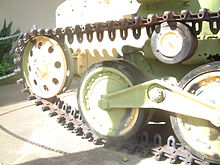 |
| Mechanical construction |
1. Robots all have a few form of mechanical production, a frame, form or shape designed to attain a selected mission. For example, a robotic designed to journey across heavy dust or mud, may use caterpillar tracks. The mechanical factor is generally the creator's approach to finishing the assigned task and coping with the physics of the environment round it. Form follows feature.
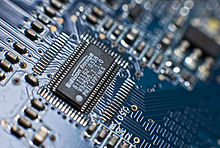 |
| Electrical aspect |
2. Robots have electrical components that strength and manipulate the equipment. For example, the robotic with caterpillar tracks might want a few sort of power to transport the tracker treads. That power comes in the form of strength, with the intention to need to tour thru a wire and originate from a battery, a primary electrical circuit. Even petrol powered machines that get their electricity specifically from petrol nevertheless require an electric powered cutting-edge to begin the combustion manner which is why most petrol powered machines like automobiles, have batteries. The electric factor of robots is used for movement (via motors), sensing (wherein electric alerts are used to measure things like warmness, sound, position, and strength popularity) and operation (robots want some degree of electrical energy furnished to their motors and sensors on the way to prompt and carry out simple operations).
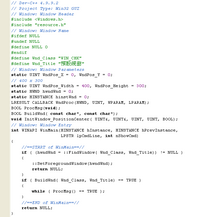 |
| A level of programming |
3. All robots incorporate a few degree of computer programming code. A software is how a robotic comes to a decision while or how to do some thing. In the caterpillar music instance, a robotic that desires to transport across a muddy road can also have an appropriate mechanical production and acquire the suitable quantity of energy from its battery, but would now not cross anywhere without a program telling it to transport. Programs are the center essence of a robot, it is able to have first rate mechanical and electrical creation, but if its application is poorly built its performance can be very bad (or it may not perform in any respect). There are three different styles of robotic programs: far off control, artificial intelligence and hybrid. A robotic with remote manipulate programming has a preexisting set of instructions that it'll handiest carry out if and when it gets a sign from a manage source, typically a human being with a faraway manage. It is perhaps extra appropriate to view gadgets controlled normally by way of human commands as falling in the subject of automation in preference to robotics. Robots that use synthetic intelligence engage with their surroundings on their personal with out a manage source, and may determine reactions to gadgets and problems they come across the usage of their preexisting programming. Hybrid is a form of programming that consists of both AI and RC capabilities in them.
Application
As more and more robots are designed for specific duties, this method of type will become extra applicable. For example, many robots are designed for assembly paintings, which might not be conveniently adaptable for different applications. They are termed as "meeting robots". For seam welding, a few providers offer entire welding systems with the robot i.E. The welding gadget at the side of different fabric dealing with centers like turntables, etc. As an integrated unit. Such an integrated robot gadget is called a "welding robot" even though its discrete manipulator unit could be adapted to a spread of responsibilities. Some robots are specially designed for heavy load manipulation, and are categorized as "heavy-obligation robots".
Current and potential applications include:
* Industrial robots. Robots are increasingly more utilized in production (for the reason that 1960s). According to the Robotic Industries Association US statistics, in 2016 automotive enterprise turned into the primary customer of business robots with 52% of general income. In the car enterprise, they can quantity for extra than half of the "labor". There are even " \ " factories along with an IBM keyboard production manufacturing unit in Texas that was completely automated as early as 2003.
* Cobots ( collaborative robots ) .
* Construction robots. Construction robots can be separated into 3 kinds: conventional robots, robot arm, and robotic exoskeleton.
* Agricultural robots (AgRobots). The use of robots in agriculture is closely linked to the idea of AI-assisted precision agriculture and drone utilization. 1996-1998 studies additionally proved that robots can perform a herding mission.
* Medical robots of diverse kinds (which include da Vinci Surgical System and Hospi).
* Kitchen automation. Commercial examples of kitchen automation are Flippy (burgers), Zume Pizza (pizza), Cafe X (coffee), Makr Shakr (cocktails), Frobot (frozen yogurts) and Sally (salads). Home examples are Rotimatic (flatbreads baking) and Boris (dishwasher loading).
* Robot fight for recreation – interest or sport event wherein or greater robots combat in an arena to disable every different. This has evolved from a interest in the 1990s to numerous TV series international.
* Cleanup of infected regions, such as toxic waste or nuclear centers.
* Nanorobots.
* Sports field line marketing.
Components
Power source
 |
| The Insight lander with solar panels deployed in a cleanroom |
At present, basically (lead–acid) batteries are used as a energy supply. Many unique sorts of batteries can be used as a strength source for robots. They range from lead–acid batteries, which can be secure and have pretty long shelf lives however are as a substitute heavy as compared to silver–cadmium batteries which can be a whole lot smaller in volume and are presently an awful lot greater steeply-priced. Designing a battery-powered robot wishes to remember factors including safety, cycle lifetime and weight. Generators, often some sort of internal combustion engine, can also be used. However, such designs are often robotically complicated and need a gasoline, require warmth dissipation and are highly heavy. A tether connecting the robot to a power deliver would cast off the energy deliver from the robotic totally. This has the gain of saving weight and space by moving all strength era and storage components someplace else. However, this layout does come with the drawback of constantly having a cable related to the robot, which may be tough to manage. Potential electricity assets will be:
* pneumatic ( compressed gases )
* solar power ( using the sun energy and converting it into electrical power )
* hydraullics ( liquid )
* organic garbag ( through anaerobic digestion )
* nuclear
Actuation
Actuators are the "muscle mass" of a robotic, the parts which convert stored electricity into movement. By far the maximum famous actuators are electric powered motors that rotate a wheel or gear, and linear actuators that control business robots in factories. There are a few latest advances in opportunity forms of actuators, powered by using electricity, chemical substances, or compressed air.
 |
| A robotic leg powered by air muscles |
Electric motors
The significant majority of robots use electric motors, often brushed and brushless DC cars in portable robots or AC automobiles in business robots and CNC machines. These cars are often preferred in structures with lighter loads, and wherein the important form of motion is rotational.
Linear actuators
Various kinds of linear actuators circulate inside and out as opposed to by means of spinning, and often have faster course adjustments, particularly whilst very massive forces are needed inclusive of with business robotics. They are commonly powered through compressed and oxidized air (pneumatic actuator) or an oil (hydraulic actuator) Linear actuators also can be powered by means of electricity which generally includes a motor and a leadscrew. Another commonplace kind is a mechanical linear actuator this is became by using hand, including a rack and pinion on a vehicle.
Series elastic actuators
Series elastic actuation (SEA) is based at the concept of introducing intentional elasticity among the motor actuator and the weight for sturdy force manage. Due to the ensuing decrease reflected inertia, collection elastic actuation improves safety whilst a robotic interacts with the environment (e.G., people or workpiece) or at some point of collisions. Furthermore, it also provides strength performance and shock absorption (mechanical filtering) at the same time as lowering immoderate wear at the transmission and different mechanical additives. This approach has correctly been hired in numerous robots, particularly advanced manufacturing robots and strolling humanoid robots.
The controller design of a series elastic actuator is most customarily executed in the passivity framework as it ensures the protection of interaction with unstructured environments. Despite its excellent stability robustness, this framework suffers from the stringent boundaries imposed on the controller which might also alternate-off performance. The reader is cited the following survey which summarizes the not unusual controller architectures for SEA in conjunction with the corresponding enough passivity conditions. One recent study has derived the necessary and enough passivity situations for one of the most commonplace impedance control architectures, specifically velocity-sourced SEA. This work is of specific significance because it drives the non-conservative passivity bounds in an SEA scheme for the first time which lets in a bigger choice of control gains.
Air muscles
Pneumatic synthetic muscular tissues additionally known as air muscle tissues, are unique tubes that expand (generally up to forty two%) while air is compelled inner them. They are used in a few robotic applications.
Muscle wire
Muscle twine, also known as shape reminiscence alloy, Nitinol® or Flexinol® cord, is a cloth which contracts (below 5%) while power is implemented. They were used for some small robot packages.
Electroactive polymers
EAPs or EPAMs are a plastic cloth which can contract appreciably (up to 380% activation pressure) from electricity, and had been used in facial muscle groups and palms of humanoid robots,[57] and to allow new robots to float,[58] fly, swim or walk.
Piezo motors
Recent alternatives to DC motors are piezo vehicles or ultrasonic cars. These paintings on a essentially extraordinary principle, whereby tiny piezoceramic elements, vibrating many lots of instances consistent with second, cause linear or rotary motion. There are exceptional mechanisms of operation; one type uses the vibration of the piezo factors to step the motor in a circle or a directly line. Another type uses the piezo elements to motive a nut to vibrate or to force a screw. The benefits of those cars are nanometer resolution, velocity, and to be had force for their length. These cars are already available commercially, and getting used on some robots.
Elastic nanotubes
Elastic nanotubes are a promising synthetic muscle technology in early-level experimental development. The absence of defects in carbon nanotubes allows these filaments to deform elastically by using numerous percent, with electricity garage levels of possibly 10 J/cm3 for metallic nanotubes. Human biceps should be replaced with an 8 mm diameter wire of this material. Such compact "muscle" may permit destiny robots to outrun and outjump humans.
Sensing
Sensors permit robots to obtain statistics approximately a positive size of the environment, or internal additives. This is critical for robots to perform their obligations, and act upon any adjustments in the environment to calculate the correct response. They are used for numerous types of measurements, to give the robots warnings about protection or malfunctions, and to provide actual-time statistics of the undertaking it is appearing.
Touch
Current robotic and prosthetic arms obtain far less tactile statistics than the human hand. Recent studies has developed a tactile sensor array that mimics the mechanical properties and contact receptors of human fingertips. The sensor array is constructed as a inflexible middle surrounded by way of conductive fluid contained by using an elastomeric skin. Electrodes are established on the floor of the rigid core and are linked to an impedance-measuring device within the center. When the synthetic skin touches an item the fluid path around the electrodes is deformed, generating impedance modifications that map the forces acquired from the item. The researchers assume that an essential feature of such artificial fingertips could be adjusting robot grip on held gadgets.
Scientists from several European countries and Israel evolved a prosthetic hand in 2009, referred to as SmartHand, which features like a actual one—permitting sufferers to write with it, kind on a keyboard, play piano and carry out different excellent movements. The prosthesis has sensors which allow the patient to experience actual feeling in its fingertips.
Vision
Computer vision is the technological know-how and technology of machines that see. As a scientific discipline, laptop imaginative and prescient is worried with the theory behind artificial systems that extract facts from images. The picture information can take many forms, such as video sequences and perspectives from cameras.
In maximum sensible pc vision applications, the computer systems are pre-programmed to remedy a specific undertaking, but techniques primarily based on getting to know are now turning into an increasing number of not unusual.
Computer imaginative and prescient systems depend upon picture sensors which detect electromagnetic radiation that is generally in the shape of both seen light or infra-red light. The sensors are designed using stable-kingdom physics. The manner by way of which mild propagates and displays off surfaces is explained the usage of optics. Sophisticated image sensors even require quantum mechanics to provide a whole know-how of the photo formation method. Robots also can be geared up with more than one vision sensors to be better capable of compute the sense of depth inside the surroundings. Like human eyes, robots' "eyes" must also be capable of attention on a particular region of interest, and also regulate to variations in mild intensities.
There is a subfield inside computer imaginative and prescient where artificial systems are designed to imitate the processing and conduct of organic gadget, at one of a kind levels of complexity. Also, some of the gaining knowledge of-primarily based strategies evolved inside laptop vision have their history in biology.
Other
Other not unusual sorts of sensing in robotics use lidar, radar, and sonar. Lidar measures distance to a target by using illuminating the target with laser light and measuring the contemplated mild with a sensor. Radar uses radio waves to decide the variety, attitude, or speed of gadgets. Sonar makes use of sound propagation to navigate, talk with or detect gadgets on or underneath the surface of the water.
Manipulation
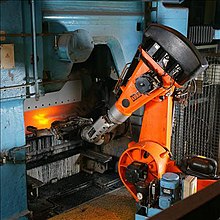 |
| KUKA industrial robot operating in a foundry |
A definition of robotic manipulation has been supplied by using Matt Mason as: "manipulation refers to an agent’s manipulate of its surroundings thru selective contact”.
Robots need to govern items; pick up, adjust, spoil, or otherwise have an effect. Thus the purposeful give up of a robotic arm meant to make the effect (whether a hand, or tool) are frequently called cease effectors, whilst the "arm" is known as a manipulator. Most robotic fingers have replaceable give up-effectors, each permitting them to perform a few small variety of responsibilities. Some have a set manipulator that can not be replaced, at the same time as a few have one very trendy motive manipulator, as an instance, a humanoid hand.
Mechanical grippers
 |
| Puma , one of the first industrial robot |
One of the most commonplace sorts of end-effectors are "grippers". In its simplest manifestation, it consists of just hands which can open and near select up and allow go of more than a few small items. Fingers can, as an example, be product of a sequence with a metallic twine run via it. Hands that resemble and paintings greater like a human hand encompass the Shadow Hand and the Robonaut hand. Hands which might be of a mid-degree complexity consist of the Delft hand. Mechanical grippers can come in numerous types, which includes friction and encompassing jaws. Friction jaws use all of the force of the gripper to hold the item in place the use of friction. Encompassing jaws cradle the object in place, the use of much less friction.
Suction end-effectors
Suction quit-effectors, powered by means of vacuum generators, are very simple astrictive devices that can maintain very huge masses provided the prehension floor is clean enough to make certain suction.
Pick and location robots for digital components and for big objects like vehicle windscreens, frequently use quite simple vacuum give up-effectors.
Suction is a exceedingly used form of quit-effector in enterprise, in component due to the fact the natural compliance of gentle suction give up-effectors can enable a robot to be more robust inside the presence of imperfect robotic perception. As an example: don't forget the case of a robot vision machine estimates the placement of a water bottle, however has 1 centimeter of error. While this can purpose a inflexible mechanical gripper to puncture the water bottle, the smooth suction cease-effector may additionally simply bend slightly and conform to the form of the water bottle floor.
General purpose effectors
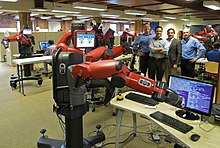 |
| Baxter, a contemporary and versatile commercial robot advanced by using Rodney Brooks |
Some advanced robots are beginning to use fully humanoid arms, like the Shadow Hand, MANUS, and the Schunk hand. These are noticeably dexterous manipulators, with as many as 20 tiers of freedom and hundreds of tactile sensors.
WRITTEN BY : ADRISH WAHEED
Labels: ROBOTIC

0 Comments:
Post a Comment
Subscribe to Post Comments [Atom]
<< Home